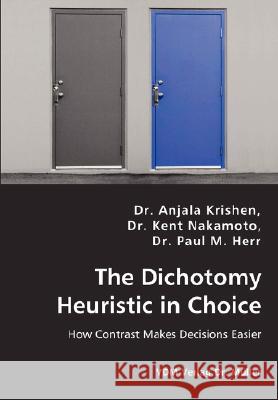The Dichotomy Heuristic in Choice - How Contrast Makes Decisions Easier » książka
The Dichotomy Heuristic in Choice - How Contrast Makes Decisions Easier
ISBN-13: 9783836441032 / Angielski / Miękka / 2008 / 204 str.
In this book, we propose that there are multiple factors, such as the education process and the consumption environment, which work to simultaneously create an opposition framework. People are constantly exposed to rival products, which are positioned to be opposites even when they are often extremely similar in chemical content and physical appearance. Thus, the implications of the recency-frequency model of activation (Higgins, Bargh and Lombardi 1985) would be that these proximal factors could, in some sense, prime dichotomous thinking. Dichotomous or oppositional thinking, as it is defined in this book, pertains to the flattening of dimensions present in a choice set such that the items can be graphically depicted at two ends of one dimension (see Figure 2 and Figure 3). We will first explore the impact of a dichotomous mindset on making a decision and then expand to the realm of opposition in choice set structures. Our findings show that when choices are presented in a dichotomous way, individuals find them less frustrating while maintaining their satisfaction with their choice.











